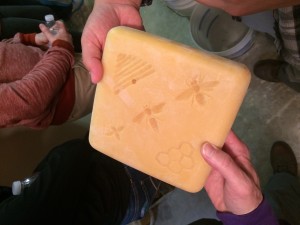We had two big activities today with a trip to a beekeepers house in the middle of corn and soy fields and a trip to a no-till farmer to hear about his practice, conservation programs, and tiling. First we visited Mark Tintjer’s house, which he built. He had built the gazebo, the house, the porch, the lake, and the majority of his beekeeping equipment. He also went to a number of fairs to present his work with his bees, including beeswax art. Even more impressively he has ~42 hives after just reading a book about keeping and trying it with two hives.
When we got there he introduced himself and told us about some basic bee information. We heard about varroa and tracheal mites, colony collapse disorder (CCD), and the problems that monocropping and insecticide use on farms causes for bees. Then we got to suit up and see several of his hives and help look for the queen bee (considerably longer, but not as wide as a male drone). Throughout this work he gave us even more information about general beekeeping, how far they travel for food, swarming, and dozens of facts about the way bees act. After transferring a few starter hives into bigger permanent ones he took us to his established colonies and let us see his technique to naturally control the varroa mite. There are three types of bees: queen, worker, and drone. The queen is biggest and lays all the eggs, the drones are only there to fertilize the queen which only occurs at the beginning of her life, and then all other bees are female worker bees. Apparently, the varroa mite has realized that the bigger drones take longer to mature so they are the preferred target for mites to lay their eggs on, and mites lay their eggs on the larvae. So Mark added a section of honeycombed sized for drones (the queen lays different eggs based on the size of the cell) to attract the mites. Before these are fully grown, but a little after they are laid, he will cut off this section with all the larva and newborn mites to feed to his birds. With this he keeps some of the mites from successfully breeding and in a chemical-free manner. In a Fear Factor-themed moment he also mentioned that people can eat the larva as a high protein snack, and almost all of us ate one of them. Unfortunately for Adam and me, they somehow taste mushroom like and both of us hate mushrooms, so it wasn’t the most pleasant taste.. He next took us to his basement where he separates comb and honey, makes beeswax candles, and creates was art such as:
Lastly he and his wife provided us with some rhubarb pie and three different honeys to taste the difference. He was experienced, self taught, conversational, and very much a man who enjoyed the work! I’m certainly interested in bees and find learning about them incredibly fascinating so this talk for me, especially from someone who had learned the vast majority of it himself through experience, was a great unexpected addition to this trip. Mark even let us each come back with some of his mold candles shaped like bees for free! I think I second another farm May-Xers opinion that it’s kind of disappointing to hear that even working so many hives on top of a small garden Mark also has to work for a pasta company to make the money to support his family.
Next we went to Glen’s farm (not our Professor Glen), but Glen Hodnefield, who farms over 1000 acres, and who uses all no-till methods on this operation.. His beliefs were that no till does not hamper the plants much, soy not at all, but that the plant debris from the previous crop keeps the rain from taking as much soil and nutrients with it. He also suggested strip tilling which just pushes the debris to the side of planted rows while adding a single file of fertilizers. This method keeps the corn happy since it doesn’t grow as well when crowded with debris. Both methods also help build soil water retention and reduce fuel needs too (no run with a tiling machine). Lastly we learned about tiling and how pipes were dug underground to drain the wetland-prairie landscape initially so that the land could be farmed. Many of these systems surprisingly still work from the early 1900s or earlier!
It was a day with two different scales and different views on conservation, both from those who do things to help the environment. This put up the interesting idea that even within environmental oriented agriculturalists there are a lot of different opinions on what is good and what isn’t (Mark was not a fan of mono crops, pesticides and fertilizer). If anyone wants more info on the bees I’d recommend checking the website of the beekeepers association of your state or some local beekeepers.

